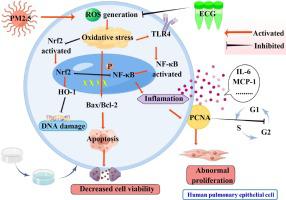Environment International ( IF 10.3 ) Pub Date : 2022-12-01 , DOI: 10.1016/j.envint.2022.107674 Jian Sun 1 , Jinjin Yu 2 , Xinyi Niu 3 , Xinya Zhang 2 , Lili Zhou 2 , Xinyao Liu 2 , Bin Zhang 1 , Kun He 1 , Xiaofeng Niu 2 , Kin-Fai Ho 4 , Junji Cao 5 , Zhenxing Shen 1

|
PM2.5 (particulate matter with aerodynamic diameter ≤ 2.5 μm) is a well-known cytotoxic pollutant that capable to induce severe intracellular oxidative stress while the underlying mechanisms remain unclear. Herein, 4 types of PM2.5 derived from solid fuel burning were selected as stimuli in A549 cells exposure model to evaluate their effects on oxidative stress and inflammatory responses. Although resulting in different responses in cell viability, all PM2.5 exhibited over 50 % higher oxidative stress than control group, expression as intracellular reactive oxygen species, malondialdehyde and superoxide dismutase levels. The Pearson’s correlation results indicated that cations (e.g., Ca2+), heavy metals (e.g., Cr and Pb), nPAHs (nitro-polycyclic aromatic hydrocarbons, e.g., 6-nitrochrysene) and oPAHs (oxygenated PAHs, e.g., 9-fluorenone) were the main functioning toxics (r > 0.6). A key finding was the dual-directional regulation function of ECG (epicatechin gallate), that is, it could either increase the low A549 cell viabilities in coal combustion PM2.5 group or reduce them in charcoal PM2.5 group (P < 0.05). The dual-directional effects were likely because ECG can activate Nrf2 oxidation signaling pathway then inhibit the inflammatory signaling pathway NF-κB accordingly. Therefore, evidences indicated cytotoxicity of solid fuel derived PM2.5 were mainly caused by oxidative stress, which was proved to be reversed by green tea, providing a potential therapy method to PM2.5 and other hazards.
中文翻译:

固体燃料衍生的 PM2.5 诱导 A549 细胞的氧化应激和相应的细胞毒性:证据和绿茶的潜在中和作用
PM 2.5(空气动力学直径≤ 2.5 μm 的颗粒物)是一种众所周知的细胞毒性污染物,能够诱导严重的细胞内氧化应激,但其潜在机制尚不清楚。在此,选择 4 种源自固体燃料燃烧的 PM 2.5作为 A549 细胞暴露模型的刺激物,以评估它们对氧化应激和炎症反应的影响。尽管导致细胞活力的不同反应,但所有 PM 2.5都表现出比对照组高 50% 以上的氧化应激,表达为细胞内活性氧、丙二醛和超氧化物歧化酶水平。Pearson 相关性结果表明阳离子(例如,Ca 2+)、重金属(例如 Cr 和 Pb)、nPAHs(硝基多环芳烃,例如 6-硝基屈)和 oPAHs(氧化多环芳烃,例如 9-芴酮)是主要的功能毒物 (r > 0.6)。一个关键发现是 ECG(表儿茶素没食子酸酯)的双向调节功能,即它可以增加燃煤 PM 2.5组的低 A549 细胞活力或降低木炭 PM 2.5组的低 A549 细胞活力(P < 0.05)。双向效应可能是因为 ECG 可以激活 Nrf2 氧化信号通路,然后相应地抑制炎症信号通路 NF-κB。因此,有证据表明固体燃料衍生的 PM 2.5具有细胞毒性主要由氧化应激引起,绿茶证实可逆转氧化应激,为PM 2.5等危害提供了潜在的治疗方法。











































 京公网安备 11010802027423号
京公网安备 11010802027423号